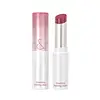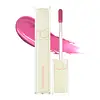What's inside
What's inside
 Key Ingredients
Key Ingredients

 Benefits
Benefits

 Concerns
Concerns

 Ingredients Side-by-side
Ingredients Side-by-side

Diisostearyl Malate
EmollientBis-Behenyl/Isostearyl/Phytosteryl Dimer Dilinoleyl Dimer Dilinoleate
EmollientPolyglyceryl-2 Triisostearate
EmulsifyingBis-Diglyceryl Polyacyladipate-2
EmollientParaffin
PerfumingTridecyl Trimellitate
EmollientPentaerythrityl Tetraisostearate
EmollientMicrocrystalline Wax
Emulsion StabilisingSorbitan Isostearate
EmulsifyingCI 77891
Cosmetic Colorant1,2-Hexanediol
Skin ConditioningDisteardimonium Hectorite
StabilisingSynthetic Wax
AbrasiveCI 19140
Cosmetic ColorantEthylene/Propylene Copolymer
AbrasiveCI 77491
Cosmetic ColorantPropylene Carbonate
SolventCI 15850
Cosmetic ColorantCI 77499
Cosmetic ColorantParfum
MaskingLimonene
PerfumingCI 42090
Cosmetic ColorantLinalool
PerfumingButyrospermum Parkii Butter
Skin ConditioningCamellia Japonica Seed Oil
EmollientCaprylic/Capric Triglyceride
MaskingArgania Spinosa Kernel Oil
EmollientSimmondsia Chinensis Seed Oil
EmollientPrunus Amygdalus Dulcis Oil
Skin ConditioningPrunus Armeniaca Kernel Oil
MaskingOenothera Biennis Oil
EmollientOlea Europaea Fruit
AbrasiveMangifera Indica Fruit Extract
Skin ConditioningRosa Canina Fruit Extract
AstringentDiisostearyl Malate, Bis-Behenyl/Isostearyl/Phytosteryl Dimer Dilinoleyl Dimer Dilinoleate, Polyglyceryl-2 Triisostearate, Bis-Diglyceryl Polyacyladipate-2, Paraffin, Tridecyl Trimellitate, Pentaerythrityl Tetraisostearate, Microcrystalline Wax, Sorbitan Isostearate, CI 77891, 1,2-Hexanediol, Disteardimonium Hectorite, Synthetic Wax, CI 19140, Ethylene/Propylene Copolymer, CI 77491, Propylene Carbonate, CI 15850, CI 77499, Parfum, Limonene, CI 42090, Linalool, Butyrospermum Parkii Butter, Camellia Japonica Seed Oil, Caprylic/Capric Triglyceride, Argania Spinosa Kernel Oil, Simmondsia Chinensis Seed Oil, Prunus Amygdalus Dulcis Oil, Prunus Armeniaca Kernel Oil, Oenothera Biennis Oil, Olea Europaea Fruit, Mangifera Indica Fruit Extract, Rosa Canina Fruit Extract
Water
Skin ConditioningBis-Behenyl/Isostearyl/Phytosteryl Dimer Dilinoleyl Dimer Dilinoleate
EmollientDiglycerin
HumectantDiisostearyl Malate
EmollientBis-Diglyceryl Polyacyladipate-2
EmollientDiphenyl Dimethicone
EmollientCetyl PEG/PPG-10/1 Dimethicone
EmulsifyingTrimethylsiloxysilicate
EmollientCaprylyl Methicone
Skin ConditioningPentylene Glycol
Skin ConditioningDimethicone
EmollientIsododecane
EmollientPolysorbate 60
EmulsifyingCeteareth-20
CleansingPhenoxyethanol
PreservativeHydroxyethyl Acrylate/Sodium Acryloyldimethyl Taurate Copolymer
Emulsion StabilisingSqualane
EmollientCI 77891
Cosmetic ColorantPolyacrylate-13
Polyisobutene
Parfum
MaskingEthylhexylglycerin
Skin ConditioningSorbitan Isostearate
EmulsifyingTrisodium Ethylenediamine Disuccinate
CI 17200
Cosmetic ColorantPolysorbate 20
EmulsifyingCI 19140
Cosmetic ColorantCI 45410
Cosmetic ColorantAluminum Hydroxide
EmollientAmmonium Polyacrylate
StabilisingCI 15985
Cosmetic ColorantButylene Glycol
HumectantCI 42090
Cosmetic ColorantPentaerythrityl Tetra-Di-T-Butyl Hydroxyhydrocinnamate
AntioxidantLavandula Angustifolia Extract
Skin ConditioningOriganum Vulgare Flower/Leaf/Stem Extract
Skin ConditioningRosmarinus Officinalis Extract
AntimicrobialThymus Vulgaris Extract
PerfumingWater, Bis-Behenyl/Isostearyl/Phytosteryl Dimer Dilinoleyl Dimer Dilinoleate, Diglycerin, Diisostearyl Malate, Bis-Diglyceryl Polyacyladipate-2, Diphenyl Dimethicone, Cetyl PEG/PPG-10/1 Dimethicone, Trimethylsiloxysilicate, Caprylyl Methicone, Pentylene Glycol, Dimethicone, Isododecane, Polysorbate 60, Ceteareth-20, Phenoxyethanol, Hydroxyethyl Acrylate/Sodium Acryloyldimethyl Taurate Copolymer, Squalane, CI 77891, Polyacrylate-13, Polyisobutene, Parfum, Ethylhexylglycerin, Sorbitan Isostearate, Trisodium Ethylenediamine Disuccinate, CI 17200, Polysorbate 20, CI 19140, CI 45410, Aluminum Hydroxide, Ammonium Polyacrylate, CI 15985, Butylene Glycol, CI 42090, Pentaerythrityl Tetra-Di-T-Butyl Hydroxyhydrocinnamate, Lavandula Angustifolia Extract, Origanum Vulgare Flower/Leaf/Stem Extract, Rosmarinus Officinalis Extract, Thymus Vulgaris Extract
 Reviews
Reviews

Ingredients Explained
These ingredients are found in both products.
Ingredients higher up in an ingredient list are typically present in a larger amount.
This ingredient is an emollient and skin conditioning agent.
This ingredient is lipid-based synthetic skin-conditioning agent derived from adipic acid and a mixture of fatty acids. It is often called a lanolin substitute.
As an emollient, it helps soften and hydrate the skin. Emollients create a barrier on the skin to trap moisture in.
Due to its fatty acid base, it may not be Malassezia folliculitis safe.
Learn more about Bis-Diglyceryl Polyacyladipate-2CI 19140 is also known as Tartrazine. Tartrazine is a synthetic dye used in cosmetics, foods, and medicine to add a yellow color.
Tartrazine is created from petroleum and is water-soluble.
Some people may experience allergies from this dye, especially asthmatics and those with an aspirin intolerance.
Learn more about CI 19140Ci 42090 is a synthetic dye created from petroleum. It is used to give a bright blue color to cosmetics, medicine, and food.
Ci 77891 is a white pigment from Titanium dioxide. It is naturally found in minerals such as rutile and ilmenite.
It's main function is to add a white color to cosmetics. It can also be mixed with other colors to create different shades.
Ci 77891 is commonly found in sunscreens due to its ability to block UV rays.
Learn more about CI 77891Diisostearyl Malate is an emollient and most often used in lip products. It comes from isostearyl alcohol, a fatty acid, and malic acid, an AHA.
As an emollient, Diisostearyl Malate helps create a thin film on your skin to trap moisture in. This helps keep your skin soft and smooth.
Parfum is a catch-all term for an ingredient or more that is used to give a scent to products.
Also called "fragrance", this ingredient can be a blend of hundreds of chemicals or plant oils. This means every product with "fragrance" or "parfum" in the ingredients list is a different mixture.
For instance, Habanolide is a proprietary trade name for a specific aroma chemical. When used as a fragrance ingredient in cosmetics, most aroma chemicals fall under the broad labeling category of “FRAGRANCE” or “PARFUM” according to EU and US regulations.
The term 'parfum' or 'fragrance' is not regulated in many countries. In many cases, it is up to the brand to define this term.
For instance, many brands choose to label themselves as "fragrance-free" because they are not using synthetic fragrances. However, their products may still contain ingredients such as essential oils that are considered a fragrance by INCI standards.
One example is Calendula flower extract. Calendula is an essential oil that still imparts a scent or 'fragrance'.
Depending on the blend, the ingredients in the mixture can cause allergies and sensitivities on the skin. Some ingredients that are known EU allergens include linalool and citronellol.
Parfum can also be used to mask or cover an unpleasant scent.
The bottom line is: not all fragrances/parfum/ingredients are created equally. If you are worried about fragrances, we recommend taking a closer look at an ingredient. And of course, we always recommend speaking with a professional.
Learn more about ParfumSorbitan Isostearate is an emulsifer and cleaning agent. It is created from isostearic acid and sorbitol.
As an emulsifier, Sorbitan Isostearate prevents oils and water from separating.
Due to its isostearic acid base, it may not be safe for Malassezia or fungal acne.
Learn more about Sorbitan Isostearate